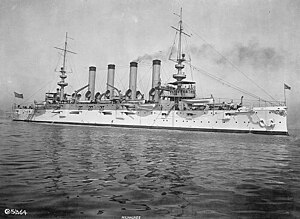 USS Milwaukee in 1900s
| |
| Class overview | |
|---|---|
| Name | St. Louis-class |
| Operators | |
| Preceded by | Denver class |
| Succeeded by | Chester class |
| Built | 1902-1906 |
| In commission | 1905-1923 |
| Completed | 3 |
| Lost | 1 |
| Scrapped | 2 |
| General characteristics (as built)[1][2] | |
| Type | Protected cruiser (Semi-armored cruiser) |
| Displacement | |
| Length | 426.6 ft (130.0 m) |
| Beam | 66 ft (20 m) |
| Draft | 24.10 ft (7.35 m) |
| Installed power |
|
| Propulsion | 2 × screws |
| Speed | 22 kn (41 km/h; 25 mph) (design) |
| Complement | 673 officers and enlisted |
| Armament |
|
| Armor |
|
The St. Louis-class cruisers were a class of three cruisers that served in the United States Navy at the beginning of the 20th century. Authorized in fiscal year 1901 by an Act of Congress of 7 June 1900 as part of the naval buildup touched off by the Spanish–American War, the St. Louis-class cruiser initially began as an improved Olympia.[2][3] However, during the design phase, decisions were made that increased the size of the vessel from 6,000 long tons (6,100 t) to 9,700 long tons (9,900 t), including adding protection that resulted in the designation "semi-armored cruiser".[2] This led to a larger power plant, and other decisions were made to try to increase speed and range, such as using smaller 6-inch (152 mm) guns instead of 8-inch (203 mm) guns, and adding coal capacity.[2] The completed ship at 9,700 long tons was the same displacement as a full armored cruiser (such as the Royal Navy's Monmouth class, launched four years prior to the St. Louis class) without the same armor.[4] One reference describes the class as "among the earliest well-documented examples of creeping growth in warship design".[2]
Milwaukee grounded near Eureka, California, and was lost in January 1917. The other ships of the class patrolled for German commerce raiders and escorted convoys in World War I, were decommissioned in the early 1920s, and were sold for scrap in 1930 in compliance with the London Naval Treaty.[3]